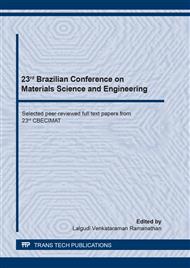p.244
p.250
p.256
p.262
p.268
p.272
p.278
p.284
p.291
Behavior of Mortar with the Addition of Sugar Cane’s Ash Residues
Abstract:
Ashes from sugar cane’s residues is quantitively the greatest mineral residue generated from sugar ethanol industries which represent high calorific value, being able to be employed in a variety of products. In this present paper, it is proposed as final objective to analyze the viability of the partial substitution of this residue in mortar, study the resistance to axial compression and determine the influence of the residue utilization as alternative source to construction materials. Based on these mechanical tests, the results reveal the substitution of up to 10% (T1) of the cbc results in the production of a mortar within the developed standards in the experiment, fitting in the P6 Class of resistance to compression mortar for settlement and lining and roofs in the Technical Norm NBR 13.281:2005, leading towards superior values higher than 8MPa.
Info:
Periodical:
Pages:
268-271
Citation:
Online since:
October 2020
Authors:
Price:
Сopyright:
© 2020 Trans Tech Publications Ltd. All Rights Reserved
Share:
Citation:


